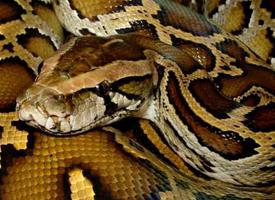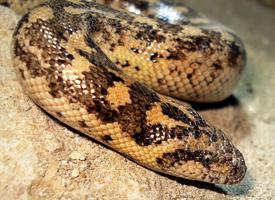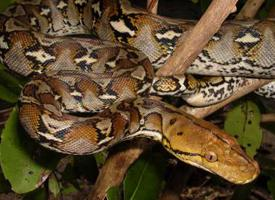
Známé také jako
- Krajta světlá
Váhy a míry
| Délka | od 5 do 8 m |
|---|
Popis zvířete
The Indian python, scientifically known as Python molurus, is a remarkable species of non-venomous constrictor found predominantly in the Indian subcontinent. This species is renowned for its impressive size, intricate patterns, and significant cultural and ecological roles. Adult Indian pythons are robust and can reach lengths of up to 3 meters (10 feet), though exceptional individuals have been recorded at lengths of up to 6 meters (20 feet), making them one of the largest snakes in the world.Physically, the Indian python exhibits a muscular build with a broad, triangular head and smooth scales. The coloration of these majestic creatures varies from light tan to dark brown, with a series of irregular, dark-edged blotches that run down the length of the body. This patterning provides excellent camouflage among the forest floors, grasslands, and wetlands they inhabit, allowing them to blend seamlessly into their surroundings.
Indian pythons are predominantly nocturnal, relying on their keen senses of smell and heat-sensitive pits located along the jaw to detect and ambush prey. Their diet primarily consists of mammals and birds. Utilizing their powerful constricting abilities, they swiftly coil around their prey, exerting enough pressure to induce cardiac arrest before consumption. Despite their fearsome hunting strategy, they pose little threat to humans and are known to be shy and reclusive.
Reproduction for the Indian python involves oviparous breeding, where the female lays a clutch of 20 to 100 eggs. Remarkably, the female exhibits maternal care by coiling around the eggs, using muscular contractions to generate heat and maintain a stable temperature until they hatch. This period of incubation lasts about 60 to 90 days.
The Indian python inhabits a variety of environments, including river valleys, jungles, and even agricultural fields, where they can sometimes be found basking in the sun during the cooler months. Their adaptability to different habitats, however, does not shield them from the threats of habitat destruction, poaching, and the illegal pet trade. These pressures have led to a decline in their populations, prompting conservation efforts to protect and preserve their natural habitats.
Culturally, the Indian python holds significant value in many South Asian traditions and myths. In some cultures, they are revered and considered sacred, associated with strength, wisdom, and longevity. However, myths and misunderstandings about these snakes often lead to fear and persecution.
In conclusion, the Indian python is a fascinating creature that plays an important role in the ecosystems of the Indian subcontinent. Its striking appearance, ecological significance, and cultural importance make it a symbol of the rich biodiversity found in the region. Conservation efforts are crucial to ensure the survival of this magnificent species for future generations to admire and study.
Podobná zvířata
Nové fotografie zvířat
Top 10 zvířat
- Chinese water dragon (Physignathus cocincinus)
- Galápagos tortoise (Geochelone nigra complex)
- Dolphin gull (Leucophaeus scoresbii)
- Japanese macaque (Macaca fuscata)
- Colombian red howler (Alouatta seniculus)
- Sea urchins (Echinoidea)
- Moustached guenon (Cercopithecus cephus)
- Diana monkey (Cercopithecus diana)
- Common reed warbler (Acrocephalus scirpaceus)
- Common house mosquito (Culex pipiens)


